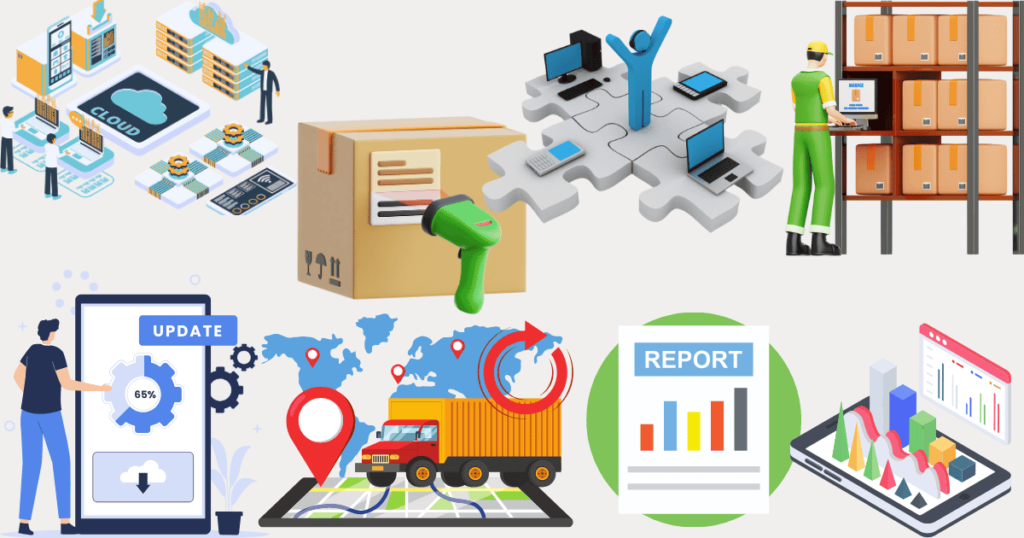Running a small enterprise in 2025 requires handling numerous tasks, particularly those related to product and order administration. The choice of adequate warehouse management software (WMS) determines success or failure during daily business operations regardless of your operating model, which includes online or physical storefronts.
A large number of small business operators continue to monitor their inventory through spreadsheets alongside minimal tools. Your business expansion creates conditions that produce errors and delays, together with customer dissatisfaction. The biggest challenges? The main warehouse management system barriers stem from expensive software combined with complex features alongside systems that do not meet basic requirements or exceed advanced functionality.
The following guide provides valuable support to address this situation.
Small businesses that need warehouse management systems can reference our straightforward guide about the top available systems for 2025. This guide provides detailed information about essential features, costs, advantages, and drawbacks, combined with authentic feedback that makes selecting your ideal solution simpler without needing technical language.
What Is Warehouse Management Software (WMS)?
Businesses utilize Warehouse Management Software as their digital tool for controlling and organizing all warehouse operations from inside the facilities. Faculty members using WMS eliminate manual work by tracking inventory and conducting outbound order management for their products.
A WMS provides its users with real-time inventory visibility, restocking information, and shipping data through a data-centric interface. The system functions as a warehouse’s operational command post and minimizes unnecessary costs through mistake prevention.

Key Functions of WMS
- Your company needs inventory tracking because it shows both present stock amounts and their current locations at all times.
- Order management provides structured systems to handle incoming and outgoing supplies, which leads to fewer administrative mistakes.
- The system enhances order fulfillment speed through automated barcode operations combined with clearly displayed instructions in the selection and packing procedures.
- Increased shipping speed occurs when the platform links businesses directly to carriers and enables the automatic creation of shipping labels.
For small businesses, using WMS can be a game-changer.
Businesses that handle larger order volumes and introduce new products as well as maintain organizational order, can save money with warehouse software. Your company achieves operational expansion through WMS implementation, which delivers error-free services at faster speeds that create superior client satisfaction.
The latest WMS tools have reached both cost-effective pricing and user-friendly interfaces. The market offers software solutions suitable for new businesses, whatever their budget situation looks like.
Key Features to Look For in a Warehouse Management System (WMS)
Every warehouse management software system delivers different features to its users. The range of warehouse management system tools features advanced capabilities, yet others emphasize basic functionality and cost-affordability. The selection process for a WMS to suit your small business needs requires the identification of essential features and their corresponding benefits.
Your search should focus particularly on the following attributes:

Inventory Management
This is the heart of any WMS. It should help you know exactly what’s in stock, what’s running low, and where each item is located. The best systems update inventory levels automatically as orders come in and go out.
Barcode Scanning
Barcode scanning minimizes mistakes in inventory picking, order packaging, and delivery activities. It also speeds up the process, simultaneously producing more accurate and swift team performance.
Real-Time Updates
The software should provide instantaneous data updates. When you use this system, you will receive constant updates about inventory and orders, together with shipping activities, with no need to guess.
Multi-Location Support
A WMS system must provide multi-location support to users who operate warehouses at different sites. Your system has to display site-specific inventory counts while enabling inventory moves between locations during execution time.
Shipping Integration
The main advantage of a quality WMS system is its capability to synchronize with shipping services, including FedEx, UPS, and USPS. The system enables automatic labeling and shipping process management along with rate computation by eliminating system migration.
Reporting and Analytics
You must have obtainable reports showing sales data with stock details and slow-moving product information, and order precision statistics. The collected data enables you to make astute business choices that accelerate your business expansion.
Cloud vs On-Premise
Cloud-based WMS is simple to set up with affordable implementation costs and lets you access the system from any location. Great for small teams.
On-premise WMS requires IT setup and ongoing maintenance, but it offers greater control. This option is better suited for businesses with custom needs or strict data security requirements.
Top WMS Tools for Small Businesses (2025)
This table compares the most suitable warehouse management software options that small businesses can consider. By examining this table, you can quickly identify features in addition to finding the most suitable solution among these tools.
| Tool | Best For | Key Features |
|---|---|---|
| Logiwa | eCommerce & DTC brands | Cloud-based, automation |
| Fishbowl | Inventory control | QuickBooks integration, barcoding |
| NetSuite WMS | Growing businesses | ERP-level features, scalability |
| Zoho Inventory | Simplicity & startups | Inventory + CRM tools |
| ShipBob | Fulfillment outsourcing | Nationwide warehouses, 3PL support |
| Cin7 | Manufacturers | B2B selling, inventory tools |
| Odoo | Flexible & budget users | Custom modules, open-source |
| QuickBooks Commerce | Inventory + accounting | Easy to use, integrates with QB |
In-Depth Reviews of the Best WMS Tools for Small Businesses
| WMS Solution | Pros | Cons | Real-World Example |
|---|---|---|---|
| Logiwa | Powerful automation for fulfillment; Built specifically for online retailers; Integrates with Shopify, Amazon, and more | Higher pricing may not suit very small startups; Some learning curve for beginners | A fast-growing online pet store used Logiwa to automate picking and shipping, cutting their order processing time by 40%. |
| Fishbowl | Seamless QuickBooks integration; Advanced inventory tracking and manufacturing features | Desktop-based unless you add cloud hosting; Interface feels outdated | A local electronics wholesaler used Fishbowl to manage their stockrooms and sync inventory directly with their accounting system. |
| NetSuite WMS | Powerful ERP features; Highly customizable and scalable | Expensive; Requires setup time and technical know-how | A nationwide health supplements brand used NetSuite WMS to unify warehouse operations across 5 locations and streamline order flow. |
| Zoho Inventory | Affordable with a free plan; Easy to use and integrates with Zoho CRM | Limited warehouse-specific features; Not ideal for complex setups | A handmade clothing shop with both online and offline sales uses Zoho Inventory to track stock and sync with their CRM. |
| ShipBob | Handles storage, packing, and shipping; Nationwide warehouse network | Not a full WMS system for in-house use; Pricing varies by fulfillment volume | A skincare brand switched to ShipBob to handle shipping, freeing up their small team to focus on marketing and product design. |
| Cin7 | Strong B2B and multi-channel selling tools; Built-in inventory and order management | Can be pricey for very small teams; Takes time to set up and train staff | A boutique furniture maker uses Cin7 to manage raw materials, production timelines, and retail sales—all in one dashboard. |
| Odoo | Open-source with lots of add-ons; Highly customizable for different industries | Can be complex without tech help; Modules may require developer support | A coffee startup began with Odoo’s free inventory module, then added barcode and sales tools as they expanded into retail. |
| QuickBooks Commerce | Smooth integration with QuickBooks accounting; Clean interface and easy product tracking | Fewer advanced warehouse features; Limited customization | A natural cosmetics firm enables QuickBooks Commerce to maintain inventory control of two warehouses while linking retail sales data to accounting information. |
How to Choose the Right WMS for Your Business
Your ultimate selection of a warehouse management system demands finding the single system that matches your operational needs perfectly instead of selecting the most well-known solution. If you operate either an online store or run inventory for expanding retail chains, then your chosen WMS must assist your team in achieving better results with less effort.
Define Your Warehouse Size and Order Volume
Start by thinking about how big your operations are.
- How many products do you manage?
- Do you ship 10 orders a day or 1,000?
The answers will help you decide if you need a basic system or a more advanced one.
Decide on Cloud or On-Premise
The setup of cloud-based WMS systems requires minimal effort and offers affordable costs with worldwide access to your data.
On-premise WMS systems maintain greater control over operations due to their use by larger businesses together with entities needing regulatory compliance. Cloud solutions represent the best solution for businesses of small size.
List Your Must-Have Features
Make a short list of what you need:
- Barcode scanning?
- Real-time tracking?
- Shipping integrations?
This will help you filter out tools that don’t meet your needs.
Set Your Budget
Different ERP systems exist on a wide price range, with free options provided by Odoo complementing high-end NetSuite solutions. Decide your monthly or yearly budget while considering implementation expenses that will be needed.
Try Before You Buy
Most WMS tools offer a free trial.
Use this time to test if the software is easy to use, works well with your team, and integrates with your other systems.
The Role of WMS in eCommerce and Retail in 2025
Warehouse management software (WMS) started as an operational tool, yet it is now essential for creating better customer experiences in e-commerce and retail. When 2025 arrives, small businesses that apply smart WMS solutions will experience major advancements in speed, accuracy, and scalability.
Key Trends in 2025
-
Automation is everywhere – From barcode scanning to auto-reordering, WMS tools are significantly reducing manual work and improve efficiency.
-
AI-driven forecasting – Some WMS systems now use artificial intelligence to predict demand, helping businesses stock more intelligently and avoid over-ordering.
-
Real-time tracking – Customers now expect fast updates. Real-time inventory and shipping data ensure that both your team and your customers stay informed at all times.
Why WMS Matters for Online Stores
Integrating your WMS with your eCommerce platform (like Shopify, WooCommerce, or Amazon) can:
- Sync inventory across all channels instantly
- Reduce overselling and stockouts
- Speed up order fulfillment with automated workflows
- Improve customer satisfaction with accurate shipping updates
Even small shops can now compete with bigger retailers, thanks to powerful yet affordable warehouse tools.
Future-Proofing Your Logistics
The shift of customers toward online shopping requires your logistics operations to adapt by delivering quick, faultless deliveries. A good WMS system provides current assistance that evolves with your business growth yet provides data for better decision-making and trend and market adaptability.
Modern WMS systems will continue to develop built-in package rate calculators alongside employee mobile workplace applications while using artificial intelligence as a basis for better understanding. Currently is the optimal moment to acquire appropriate groundwork when expansion remains on your horizon.
Conclusion
Warehouse management software isn’t just for big companies anymore. In 2025, even small businesses can use powerful tools to track inventory, streamline fulfillment, and grow with confidence.
The key is finding a WMS that matches your current needs but also supports your future goals. Whether you’re running a home-based e-commerce shop or a multi-location retail business, the right solution can save time, reduce errors, and improve customer satisfaction.
FAQs
What’s the cheapest WMS for small businesses?
Zoho Inventory and Odoo are great budget options. Odoo even has a free version!
Can WMS work with Shopify, WooCommerce, or Amazon?
Yes! Most WMS tools connect easily with Shopify, WooCommerce, Amazon, and more.
Is WMS hard to set up?
Some are super easy (like Zoho or Logiwa), while others may need expert help (like NetSuite).
Do I need barcode scanners?
Not required, but helpful! They speed things up and reduce errors.
Can I try WMS for free?
Yes! Odoo and Zoho offer free plans with basic features that are great for small teams.

Rosie Harman, a seasoned Senior Content Strategist with 7 years of expertise in the field of Technology, earned her Master’s in Business Administration from The University of Texas at Arlington. She has dedicated the majority of her career to contributing her skills and knowledge to prominent tech giants based in Texas.


















